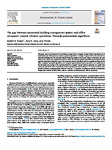The gap between automated building management system and office occupants' manual window operations: Towards personalised algorithms
| dc.contributor.author | Korsavi, Sepideh Sadat | |
| dc.contributor.author | Jones, Rory | |
| dc.contributor.author | Fuertes, Alba | |
| dc.date.accessioned | 2021-10-09T07:04:35Z | |
| dc.date.available | 2021-10-09T07:04:35Z | |
| dc.date.issued | 2021-12 | |
| dc.identifier.issn | 0926-5805 | |
| dc.identifier.issn | 1872-7891 | |
| dc.identifier.other | 103960 | |
| dc.identifier.uri | http://hdl.handle.net/10026.1/18016 | |
| dc.description.abstract |
This paper aims to demonstrate how knowledge acquired from occupants' manual window operations can be implemented into BMS automated window operation algorithms. Ten single-occupant offices were selected in a university building in the UK. More than 28,000 hourly data points on indoor and outdoor temperature and open window area (OWA) were analysed from 2015 to 2020. The BMS had adopted nine different automated window operation algorithms during the 5 years. The automated window algorithms could be manually overridden by the office occupants. Automated algorithms were compared against manual window operations. The results showed that the slope and gradient of the regression lines for occupants' manual window operations are smaller than automated operations. OWA of automated window operations increased 20% per 1 °C increase in indoor temperature, however, occupants opened windows 6–8% per 1 °C increase. Occupants react slower to temperature changes than assumed by BMS, which could be considered in BMS automated window operations. | |
| dc.format.extent | 103960-103960 | |
| dc.language | en | |
| dc.language.iso | en | |
| dc.publisher | Elsevier | |
| dc.rights | Attribution 4.0 International | |
| dc.rights | Attribution 4.0 International | |
| dc.rights | Attribution 4.0 International | |
| dc.rights.uri | http://creativecommons.org/licenses/by/4.0/ | |
| dc.rights.uri | http://creativecommons.org/licenses/by/4.0/ | |
| dc.rights.uri | http://creativecommons.org/licenses/by/4.0/ | |
| dc.subject | Window operation | |
| dc.subject | Open window area (OWA) | |
| dc.subject | Building management systems | |
| dc.subject | Office occupants | |
| dc.subject | Behaviour gap | |
| dc.subject | Personalised control | |
| dc.subject | Automated algorithms | |
| dc.title | The gap between automated building management system and office occupants' manual window operations: Towards personalised algorithms | |
| dc.type | journal-article | |
| dc.type | Journal Article | |
| plymouth.author-url | https://www.webofscience.com/api/gateway?GWVersion=2&SrcApp=PARTNER_APP&SrcAuth=LinksAMR&KeyUT=WOS:000701923200002&DestLinkType=FullRecord&DestApp=ALL_WOS&UsrCustomerID=11bb513d99f797142bcfeffcc58ea008 | |
| plymouth.volume | 132 | |
| plymouth.publication-status | Published | |
| plymouth.journal | Automation in Construction | |
| dc.identifier.doi | 10.1016/j.autcon.2021.103960 | |
| plymouth.organisational-group | /Plymouth | |
| plymouth.organisational-group | /Plymouth/Faculty of Arts, Humanities and Business | |
| plymouth.organisational-group | /Plymouth/REF 2021 Researchers by UoA | |
| plymouth.organisational-group | /Plymouth/REF 2021 Researchers by UoA/UoA13 Architecture, Built Environment and Planning | |
| plymouth.organisational-group | /Plymouth/Users by role | |
| plymouth.organisational-group | /Plymouth/Users by role/Academics | |
| dcterms.dateAccepted | 2021-09-09 | |
| dc.rights.embargodate | 2021-10-12 | |
| dc.identifier.eissn | 1872-7891 | |
| dc.rights.embargoperiod | Not known | |
| rioxxterms.versionofrecord | 10.1016/j.autcon.2021.103960 | |
| rioxxterms.licenseref.uri | http://creativecommons.org/licenses/by/4.0/ | |
| rioxxterms.licenseref.startdate | 2021-12 | |
| rioxxterms.type | Journal Article/Review |



